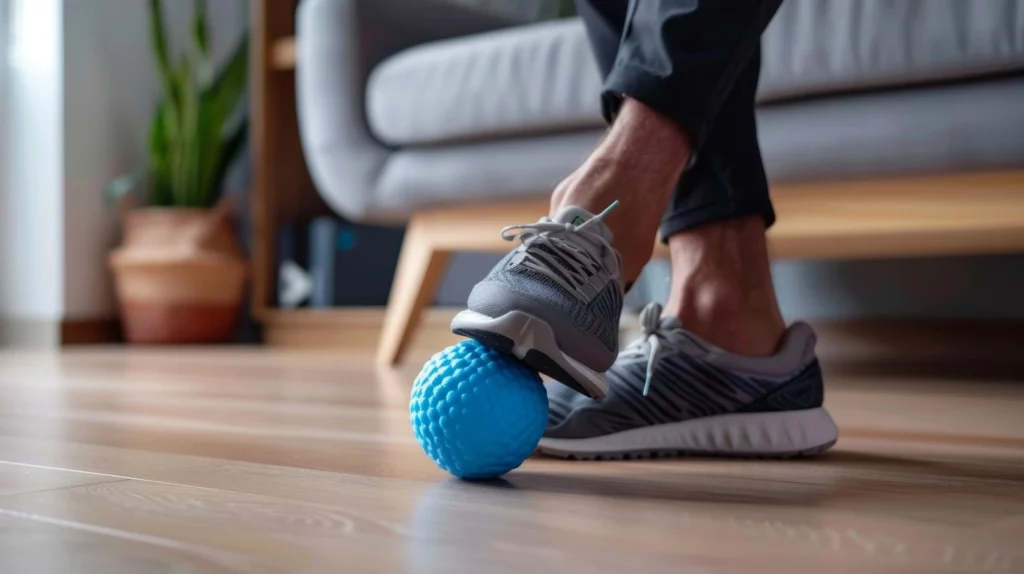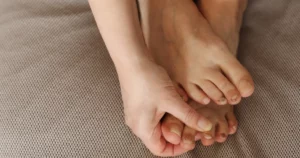
Table of Contents
The problem of heel pain affects people of all ages and levels of activity. There can be debilitating effects on your daily activities and your overall quality of life if you suffer from it.
Plantar fasciitis is a prevalent cause of heel pain. The plantar fascia, which extends from your foot’s heel bone to your toes, is inflamed, which is why it occurs. In addition to discussing heel spurs, one of the problems related to plantar fasciitis, this extensive blog article tries to educate individuals on plantar fasciitis, including its symptoms, treatments, and preventative measures.
What is Plantar Fasciitis?
Plantar fasciitis impacts the ligament that supports the arch of your foot, the plantar fascia. Most often, severe strain or straining results in tiny tissue rips, producing inflammation. Sharp, localized heel pain is the usual symptom of plantar fasciitis, especially after extended rest or during morning movement.
Causes of Plantar Fasciitis
It is possible to develop plantar fasciitis due to a number of factors, including:
- Plantar fasciitis can develop from overuse of the heel and attached tissues, such as long-distance running, ballet dancing, and aerobic dancing.
- An irregular posture or flat feet can impact the distribution of weight when standing, straining the plantar fascia.
- Being overweight puts additional strain on your plantar fascia.
- If your profession demands you to travel long distances on hard surfaces or stand for extended periods of time, you are at risk.
- The age range of 40 to 60 is the most prevalent for plantar fasciitis cases.
- Plantar fasciitis is caused by inappropriate footwear, such as shoes with poor arch support or soft soles.
Symptoms of Plantar Fasciitis
Plantar fasciitis typically causes heel pain as a primary symptom. This pain is usually:
- Sharp and Stabbing: Most people describe the pain as sharp and stabbing, especially during the first steps after waking up.
- Localized: The pain is typically felt at the bottom of the heel.
- Worse After Inactivity: It is common for pain to increase after long periods of rest, such as sleeping or sitting, and to diminish as soon as you start moving.
- Worse After Exercise: Though exercise may not cause pain, the discomfort can increase after physical activity.
Heel Spurs and Plantar Fasciitis
Heel spurs are another common foot condition often associated with plantar fasciitis. A heel spur is a bony growth that develops on the front part of the heel bone and points toward the arch of the foot. It’s estimated that heel spurs occur in at least 50% of people with plantar fasciitis. These spurs can add to the discomfort and pain, but it’s important to note that not everyone with a heel spur experiences pain.
Past and Present Treatments for Heel Spurs
In the past, surgical removal of the heel spur was a common treatment. However, this approach is rarely used today due to advances in less invasive treatments. Current management of heel spurs typically includes:
- Physical Therapy: Stretching exercises to improve flexibility in the Achilles tendon and plantar fascia.
- Ice Therapy: Applying ice packs to the affected area to reduce inflammation and pain.
- Pain Medications: To manage pain, nonsteroidal anti-inflammatory drugs (NSAIDs) like ibuprofen or aspirin.
- Orthotics: Custom-made shoe inserts to provide better arch support and reduce strain on the plantar fascia.
- Night Splints: Wearing a splint that keeps the foot flexed overnight to stretch the plantar fascia.
Diagnosis and Treatment of Plantar Fasciitis
It’s important to get a professional diagnosis if you think you could have plantar fasciitis in order to rule out other possible reasons. Medical professionals will undertake imaging tests like MRIs and X-rays in addition to a physical examination.
Non-Surgical Treatments
There are a number of non-surgical treatment options that can be used to treat plantar fasciitis. These include:
- A break from activities that aggravate your condition: Give your feet a break from activities that aggravate it.
- Applying ice packs to reduce inflammation and pain is one of the best ways to reduce inflammation.
- The use of NSAIDs is considered to be a pain relief method.
- Modifications to footwear: Wear supportive, cushioned shoes that provide good arch support.
- A number of stretching exercises can be performed in order to strengthen and stretch the plantar fascia and Achilles tendon.
- In order to support the foot arch, orthotics are used as custom-made shoe inserts that are made to fit your shoe.
Advanced Treatments
If non-surgical treatments are not effective, more advanced options may be considered, such as:
- Corticosteroid Injections: Using anti-inflammatory medication directly in the affected area.
- Extracorporeal Shock Wave Therapy (ESWT): Using sound waves to stimulate healing in the plantar fascia.
- Tenex Procedure: A minimally invasive procedure that removes scar tissue from the plantar fascia.
Prevention of Plantar Fasciitis
Preventing plantar fasciitis involves addressing the risk factors that can contribute to its development. Here are some effective strategies:
- Wear Supportive Shoes: Choose footwear that provides good arch support and cushioning. Avoid high heels and shoes with worn-out soles.
- Maintain a Healthy Weight: Keeping your weight in check reduces stress on your feet.
- Incorporate Foot Exercises: Regular stretching and strengthening exercises for your feet and lower legs can improve flexibility and support.
- Use Orthotics: Custom-made shoe inserts can provide additional support.
- Avoid Overuse: In order to prevent overstretching your plantar fascia, gradually increase the time and intensity of your physical activity.
When to See an Expert?
Heel pain can significantly impact your quality of life, and knowing when to seek professional help is essential. If you experience any of the following, it’s time to consult with a healthcare provider:
- Persistent heel pain that doesn’t improve with home treatments.
- Severe pain that makes walking difficult.
- Swelling or redness in the heel area.
- Pain accompanied by fever or other signs of infection.
Conclusion
Heel pain is a common and frequently debilitating symptom of plantar fasciitis. By being aware of its causes, symptoms, and available treatments, you can take proactive measures to manage and avoid this illness.
Remember, effective treatment begins with a professional diagnosis and personalized care. Contact Integrity Foot and Ankle Associates for expert guidance and support in overcoming heel pain and reclaiming your active lifestyle.




